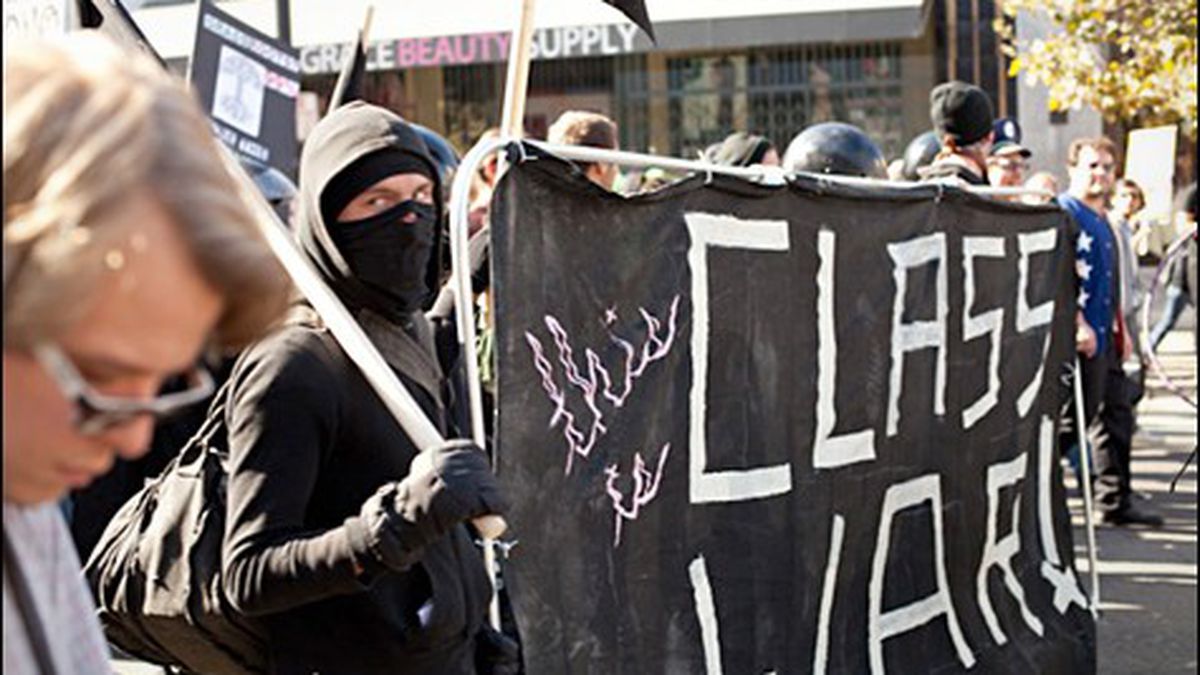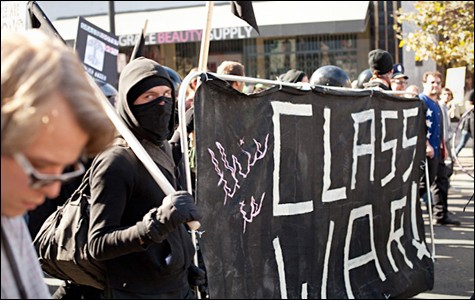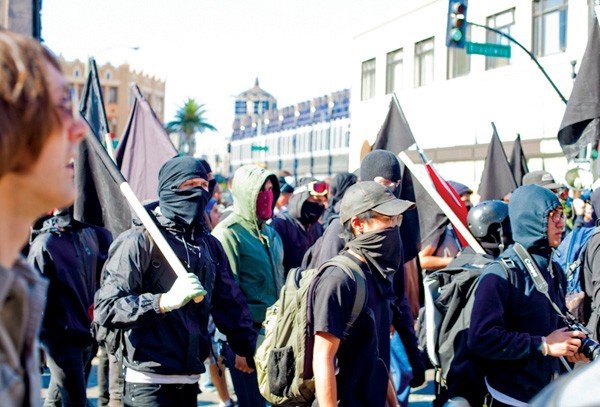Since last week, the conventional wisdom among progressives has been that Occupy Oakland needs to condemn and expel the black-clad vandals who seek out violent clashes with police. The morning after last week’s general strike turned into a night of chaos, many liberals showed up at Occupy Oakland urging demonstrators to embrace nonviolence, and some protesters responded in kind, by helping clean up debris and graffiti in downtown Oakland.
But over the past week, the Occupy Oakland General Assembly has stopped short of denouncing violence, even though many occupiers have distanced themselves from what happened last Thursday morning. At times, calls for peace have been shouted down by the more militant members of the movement. In fact, since last week’s events, there appears to be a contingent at Occupy Oakland that is openly embracing violent tactics.
Oft called “The Black Bloc,” or “the anarchist wing” of Occupy Oakland (even though many anarchists scorn them), the small group who turned last week’s protest into chaos uses a methodology that gained currency after the 1999 World Trade Organization demonstrations in Seattle. They dress in black and obscure their faces with ski masks or bandanas, both to conceal individual identities, promote “solidarity” (i.e., the group looks like one autonomous bloc), and make it difficult for police to apprehend the protesters who throw rocks or light trash cans on fire.
Not all Black Bloc protesters are violent; some merely wear the uniform as a fashion statement, or to show sympathy for their counterparts. One occupier said the black dress helped prevent mass arrests and persecution of individuals. He emphasized that Black Bloc protesters don’t subscribe to any uniform political ideology — meaning that not all believe in violent revolution.
But prior to last week, the Black Bloc didn’t seem to play a strong part in Occupy Oakland. When a group called the Oakland Liberation Front distributed “anti-peace brigade” fliers a couple days before the general strike, its members were largely denounced. When angry protesters advanced toward a line of cops during the October 29 march against police brutality, peaceful demonstrators intervened. In fact, the Black Bloc was a very small minority on the morning of the general strike. Wednesday’s peaceful protest was dominated by union members and progressives who had not been camping out at City Hall.
Members of the Service Employees International Union (SEIU) had marching orders to help direct traffic, diffuse conflicts, and keep the peace as large groups of people disrupted service at each of the big banks downtown. For the most part, the peace-keepers were successful. Even after a group of Black Bloc rogues broke off from the main protest to vandalize Whole Foods, the strike remained largely nonviolent. At 4 p.m., a giant group of strikers marched through West Oakland, en route to shut down the port. A couple people in front wheeled a life-size Gandhi float. People held signs that criticized bank bailouts and reframed the protest in economic terms. For a time, it looked as if the general strike would be wildly successful.
But then as the evening wore on, the Black Bloc grabbed control. A group of thirty to fifty such protesters converged on an abandoned, foreclosed building that had formerly been home to a homeless services center. They broke in, and “occupied” the space. They handed out a prepared statement. It read: “The Oakland branch of the Traveler’s Aid Society was a government-funded non-profit that provided aid to houseless people in our area. After the government cut funding to the program the Oakland branch faced foreclosure at the hands of their private lender.” The protesters’ plan? Reclaim the building. Turn it into a library and workshop center. “We are the 99 %,” the statement ended. “This is our future.”
By itself, the takeover seemed to be in line with the Occupy Oakland’s apparent new emphasis on direct action, rather than mere protest. More and more, protesters at Occupy Oakland have begun calling for appropriation and reclamation of space. Several speakers at the General Assembly meetings late last week called for “strategic occupations of empty buildings.” Some argued that such “occupations” should occur by any means necessary, even if the occupiers had to build barricades, or light fires, or throw rocks at police in order to defend their territory. One woman who spoke at Thursday’s meeting presented her view in stark, us-versus-the-system terms. “The amount of violence necessary to overthrow this monster is beyond what we currently have,” she said. “So we have to be tactical, and outsmart those who outnumber us.”
It wasn’t clear whether the protesters who took over Traveler’s Aid intended violence. But shortly after midnight, when word came that police were headed over to shut down the protest, the demonstrators took action. They began building massive barricades at both the San Pablo and Telegraph intersections of 16th Street, using anything they could find — Dumpsters, recycle bins, pallets from the Occupied Oakland encampments, city-issued garbage cans. A black man who appeared to be there with his family (and who may or may not have been part of the occupation) attempted to take one of the barricades down. He said he lived in the neighborhood and that he, too, was part of the 99 percent, but he didn’t approve of vandalism. A group of protesters surrounded him, yelling obscenities. Some accused him of being an agent provocateur. Vastly overwhelmed, the man finally left. One person observing the scene said it looked as though they’d been trained to intimidate intruders, or that it could have been “a mob mentality.”
Then the group of Black Bloc demonstrators set fires. Their exact motivation for doing so wasn’t clear. When Occupy medic Douglas Connor arrived shortly after 1 a.m. and asked what the fire was for, he got a matter-of-fact response from one of the protesters standing guard. “Fires help dissipate tear gas,” the protester said. Apparently, they’d all read it somewhere in a protest manual.
By then, the scene had devolved into chaos. Police closed in on the crowd gathered at and around Frank Ogawa Plaza and issued a dispersal order that few people could hear over the clamor. A fire truck arrived to put out the fire. Police fired tear gas and bean bags, hit protesters with batons, and made about one hundred arrests — including Connor, who was standing by in his military fatigues (he’d served two years at Walter Reed and one in Iraq) with red crosses taped on the sleeves, waiting to see if anyone needed medical attention. In fact, several medics were arrested that night, along with members of the National Lawyers Guild, bloggers, people visiting from the Occupy encampments in Sacramento and Los Angeles, students fretting about term papers they had to write the following day, and members of a group who huddled on the ground in front of City Hall, holding up peace signs. Most people were charged with failure to disperse; a few got hit with vandalism charges. It’s still unclear whether anyone who was arrested that night was part of the original building takeover.
“I don’t think anyone who was wearing all black [got arrested],” Connor said. “The Black Bloc is very wily. They do stuff to instigate, and then when it gets hot, they leave.”
The next morning, Occupy Oakland experienced a major crisis of faith. Liberals and progressives immediately called for nonviolence, dismayed that the public’s perception of the movement had changed overnight. Local anarchist Jason Hoopes even wrote a vituperative “open letter” to the Black Bloc: “As an anarchist, I am deeply disappointed in you,” Hoopes wrote. “I am angry at you. I am saddened by you. I feel let down by you. I feel nearly irreparably misrepresented by you.”
But even in the face of criticism, members of the Black Bloc contingent were emboldened. Some of them reframed the incident in terms of self-defense rather than police provocation, arguing that building seizures were a logical next step for the Occupy movement, and that they needed a burning barricade to defend their new encampment. Occupy Oakland had started out populist and has become increasingly tribal and territorial. And within its new discourse, the self-defense argument has been striking a chord.
Black Bloc violence is highly organized, and it relies on a familiar set of tropes: arson, rock-throwing, barricade-building, and public-street seizures. Whereas the larger group had previously disparaged such tactics, it seemed that many now condone them — or at least refuse to condemn them. Now, speakers at the assembly meetings routinely advocate for violent retaliation against the police. When a man who introduced himself as an “Indian nonviolence trainer” stood before the crowd at Thursday’s meeting and admonished that Black Bloc tactics had tarnished the reputation of Occupy Oakland at large, he was jeered. A social worker stood up shortly thereafter, and preached the opposite message: “The overthrow of capitalism isn’t going to happen nonviolently,” she said. The crowd erupted. A speaker on Friday even argued that there actually isn’t a hard dividing line between “violent” and “nonviolent” factions at Occupy Oakland. He accused “the bourgeoisie media” of purposefully creating schisms in order to undermine the movement at large. “They want us to eat each other alive,” the man insisted.
But for all his protestations, it seems clear that Occupy Oakland is currently at cross-purposes with itself. And it’s not only divided into “violent” and “nonviolent” camps; it actually has at least five different strata. There are the ideologues who think that violence is the only way to properly overthrow a system. They tend to be highly ideological, and even academic — or at least very well-versed in protest-speak. There are the non-ideologues, who enjoy wreaking havoc-for-havoc’s sake. They’re the ones who graffiti storefronts and curse at the police, but usually act in an irrational, disorganized way. Then, there are the people who don’t commit violence, but sympathize with others who do. They dress in all black at protests to create uniformity and help vandals get away — incidentally, there’s a huge “anti-snitch” culture at Occupy Oakland. “I don’t think we should do the police’s work for them,” said an occupier who called himself Louis Michel.
On the other side are the nonviolent protesters, but they also vary. Some believe in radical change and endorse building seizures or appropriation of public space, but say it should happen without recourse to vandalism. Others adhere to the values of Occupy Wall Street, but disassociate themselves, wherever possible, from the radical, tactical methods of the Black Bloc. That last school includes all the mainstream labor advocates and union members who participated in Wednesday’s general strike, left happily at 10 p.m., and were appalled to wake up Thursday morning and find the narrative had completely changed. SEIU spokesman Carlos Rivera said the delineation between “occupiers” and agitators needs to be a lot sharper: “We were so happy that people came together for the right cause,” he said, referring to the general strike and port shutdown. “And then bandits stole it away from us.”
It’s unclear what the future bodes for Occupy Oakland as the weather gets colder, the General Assembly meetings get bigger, and the Black Bloc appears to gain traction. Still, it’s hard to see Occupy Oakland generating any kind of sustainable protest movement, unless it eschews violence. It’s axiomatic that change is hard, and long, and boring, and full of interminable negations, and it’s much easier to just start a riot. A student activist named Gustavo Oliveira drew that conclusion last week: “If we’re not gonna have riots, we have to work even harder [at] community organizing to get the job done,” he said. “Otherwise we leave it to people who see no other option than to fuck shit up.”
















